Co-living startup Common is expanding to Miami, developer David Martin announced at The Real Deal South Florida’s transportation and real estate event this week.
Martin, president and co-founder of Terra, Brightline Chief Development Officer Mike Salzman, Miami Worldcenter developer Nitin Motwani, Blanca Commercial Real Estate CEO Tere Blanca, and Greater Fort Lauderdale Alliance CEO Bob Swindell were joined by Ina Cordle, moderator and managing editor of The Real Deal South Florida, at Brightline’s MiamiCentral station on Wednesday for a panel discussion on how transportation is impacting the real estate industry.
Martin and Grass River Property just broke ground on Grove Station, a mixed-use, transit-oriented project planned next to the Coconut Grove Metrorail station. The development will have 130,000 square feet of retail space and 350 apartments, some of which will be managed by Common.
The co-living company, whose competitors in South Florida include PMG’s X Social Communities, will be entering the Miami market at the Coconut Grove project. Rooms will be priced about 30 percent below a studio, Martin said.
“As a lot of these cities start investing in east-west corridors, we’re seeing a change in psychology about transit,” he added. The Metrorail runs east to west and connects near MiamiCentral at the Historic Overtown/Lyric Theatre Station.
Brightline launched service in West Palm Beach a year ago, later opening the Fort Lauderdale and Miami stations. Salzman expects the Orlando leg will start operating trains in 2022 and will eventually include a stop at Walt Disney World.
In December, Brightline recorded more than 100,000 riders, he said. Tri-Rail will connect at the MiamiCentral station, crossing over onto Florida East Coast Railway lines at Northeast 79th Street sometime over the next 12 months. That could add 5 million people to MiamiCentral, according to Salzman.
Brightline will soon rebrand as Virgin Trains USA. The private passenger train operator announced last year that Richard Branson’s Virgin Group took a minority stake in the company. But the initial public offering will be delayed to the government shutdown, Salzman said.

Crowd at the event (Credit: Rebecca Lattanzio)
Near MiamiCentral, thousands of residential units are underway within a few blocks. Blanca compared the potential transformation to what happened in the Brickell neighborhood once residents moved in. “That spills out very quickly into restaurants, stores. It becomes a community really quickly,” she said.
At the nearby Miami Worldcenter, CIM Group and Falcone Group completed Caoba, a 444-unit rental building. Next up is Paramount Miami Worldcenter, a 60-story condo tower. Hines is also developing an office building at Worldcenter “because of the train,” Motwani said.
“In order to really connect and fill 350,000 square feet of office space, you really have to have a regional impact,” he added.
Motwani referred to Miami Worldcenter as “the hole in the doughnut,” because of all the development that has taken place close by, including the Phillip and Patricia Frost Museum of Science and the Perez Art Museum Miami, as well as MiamiCentral.
Blanca, who handled leasing at MiamiCentral, said “we probably could be charging a higher premium” for new office space, citing a 40 percent increase in Class A rents over the last five years in Miami.
Development has also heated up near Brightline’s Fort Lauderdale and West Palm Beach stations.
Swindell and Motwani said one hurdle the region faces is the perceived barriers of crossing county lines.
“We’re competing with Dallas and Atlanta. Growing up in Fort Lauderdale and moving to Miami, you realize how real that barrier is,” Motwani said. “We need to do a better job of talking about South Florida.”
Keith Larsen contributed to this report.
